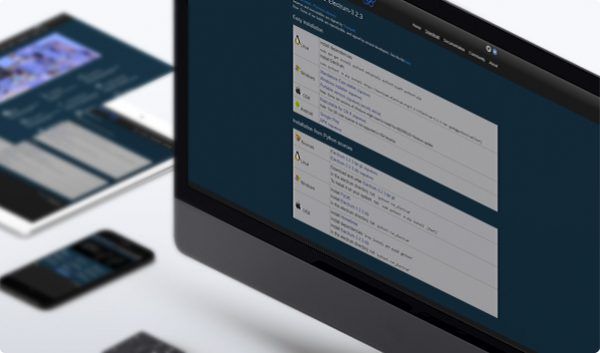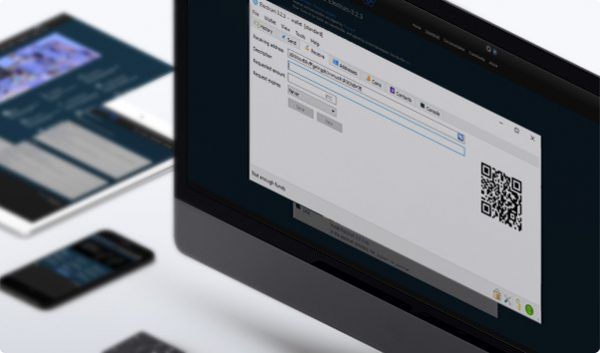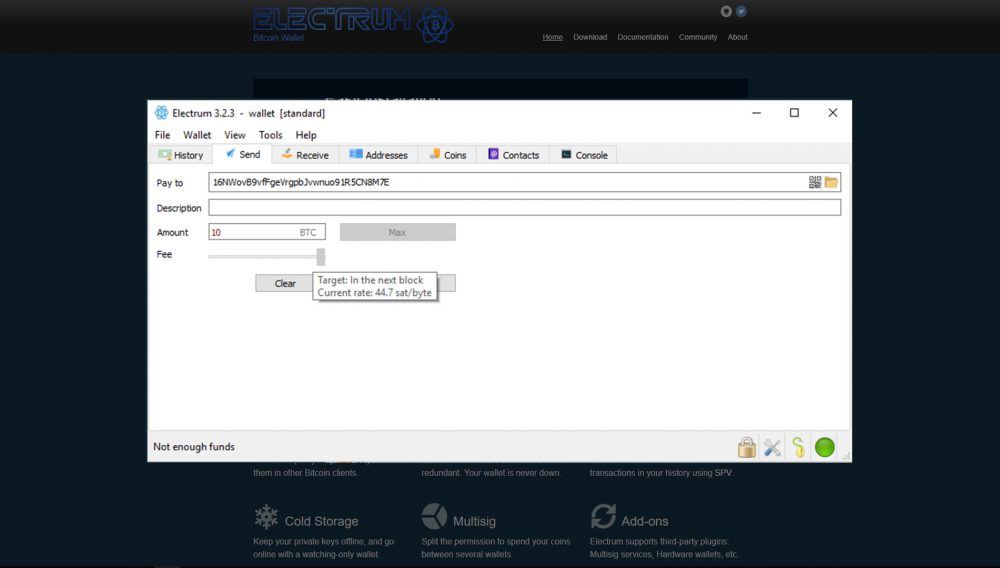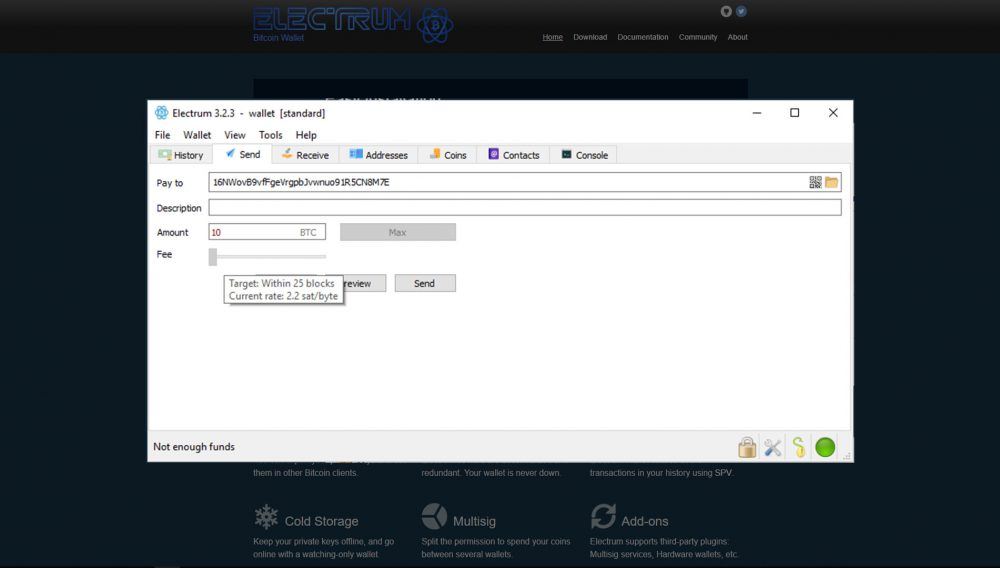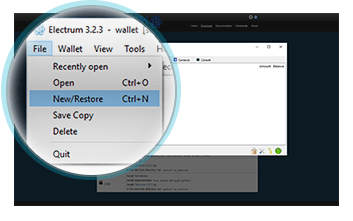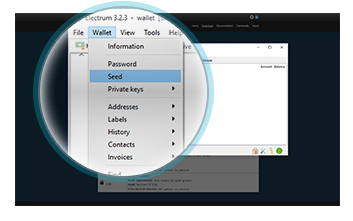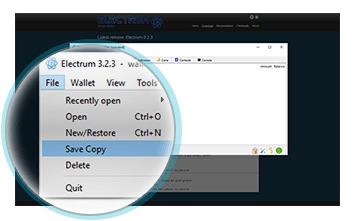
Open Source
Good Support Desk
Multiplatform Support
No Multi-Coin Support
Hierarchical Deterministic (HD)
Private Key Ownership
Two-Factor Authentication
Multisignature
Electrum Wallet Review: Features and How-to-Use Guide
This Electrum review is going to show you all the security and anonymity features that benefit the users of this wallet. It is considered one of the oldest and most secure wallets when it comes to storing Bitcoin. At the end of the article, you’re going to find a full Electrum guide to lead you step by step through the installation of the wallet and how to use it.
01.Electrum Features & Fees
Let me start with the basics – Electrum is a single coin wallet, supporting only Bitcoin. It’s one of the most preferred platforms to send and receive BTCs, because of the fast and easy setup process. It’s considered an anonymous wallet with privacy features, which makes it a tasty bite for users. Its HD characteristic allows people to easy backup and restore their wallet, thanks to the generating seed.
As a light node, Electrum is requesting information from full nodes. Here I observe the SPV (Simple payment verification) confirmation. This one verifies that your transactions are added in the blockchain.
If I have to be honest, when I initially installed Electrum, it was a bit hard for me to work with the interface. It might not be the most user-friendly on the market but once you get used to it, you’ll forget the struggles in the beginning. I would like to sum now everything I’m planning to show you with the following sections, so you can have an exact idea how am I going to proceed:
Pros & Cons
I would like to clear the air from the very beginning, providing you the advantages and disadvantages of the Electrum wallet. This will help you create an impression and sift the important information. Check the table below and make an informed decision:
- Open SourceEach user is able to read and edit the code
- Two-Factor AuthenticationThere’s an additional security layer asking some extra information to sign in
- MultisignatureAn option which requires several people to sign a transaction to get broadcasted
- Hierarchical Deterministic (HD)Automatically generates your key credentials, which makes it easy to backup and restore later
- Single-Coin Support Supports only Bitcoin
- Unfriendly Interface Not the easiest to use interface and a bit unfriendly design
Operating System Compatibility
As explained earlier, Electrum is supporting only the BTC coin, so basically there isn’t much to say about the coin support. I would like to talk you about the operating systems. It’s supporting all the Desktop editions – Windows, Linux and Mac. You simply download and set up the Electrum desktop wallet on your personal PC. Another thing to mention here is that there’s also an Android mobile app, which you can download from your app store and install on your smartphone without any minimum requirements. In a word, all the OS, supporting the python3 coding language are compatible with Electrum. Anyway, I’ll commit my resume on the most popular ones:
-
WindowsWindows
Windows 7 or higher
-
LinuxLinux
Ubuntu 16.04 or higher
-
Mac OSMac OS
X 10.11 or higher
-
Google PlayAndroid
Android 5 or higher
Is Electrum Safe?
Security
One of the most wanted factors, when choosing a wallet is the protection level it offers. So, for those of you wondering if Electrum is safe enough, I would like to remind you that it’s a desktop wallet, which means it’s a hot one. Ultimately, it’s connected to the Internet all the time when running, which makes it vulnerable when speaking of hacking attempts. Well, if you upgrade frequently the software, you’ll be able to profit the latest security features. How does it work? You should manually download and reinstall the wallet from the official webpage.
I would like to say a few words on the private key control. It’s you and only you in charge of your private keys. You can and have to keep your private credentials safe to avoid any attacks. You can also export it any time you wish to. Let me give now some additional details on the particular Electrum security features:
Open Source
Тhis means that anyone is able to read and edit the Electrum code. In fact, lots of providers are using this wallet’s core to build other wallets.
Encryption
Here you’re able to create a password to keep safe your bitcoins from cyber-attacks.
Two-Factor Authentication
You’re able to profit an additional security layer, which provides you the opportunity to secure your wallet by requesting some extra information to sign up, such as the powered by Trustedcoin multisignature. Here you have 2 of 3 keys and Trustedcoin have the other 1. Trustedcoin service is signing the transaction on your behalf acts as a second factor.
Multisignature
This feature provides you the opportunity to work in collaboration, since it requires several people to sign a transaction to get broadcasted in the network.
Privacy and Anonymity
I want to add a few words on privacy, because sometimes it happens to be the most important factor for some users to choose their wallet. If you would like to stay anonymous when performing transactions and you don’t like the idea that everybody can surveil your transactions, there’s something you might use in Electrum.
Hierarchical Deterministic (HD)
This means that Electrum doesn’t reuse the same address for every transaction. Actually, each time you want to receive bitcoins, it can generate for you a new public address to secure your signature.
Virtual Private Network (VPN)
It means that it’s encrypting your traffic, using multiple servers, which makes it hard to track your transaction history.
Tor Network
Using his feature gives you the opportunity to perform anonymous and free of surveillance internet operations.
Is Electrum the Wallet For You?
Download HereTransaction Fees
With Electrum, the software sets transaction fees automatically, but you can still change them depending on the urgency of your transactions or in other words, how fast you need them to go through. When you want to send coins using that wallet, use the slider for adjusting the fee. This software option shows you roughly after how many blocks your transaction will go through. The fees you need to pay are estimated according to the ones used in the last blocks.
The tricky part about manually adjusting the fees in your wallet is connected to the time each transaction will be processed by the miners. In case the fee you put is too small, there is a chance your transaction never to go through. Well, don’t worry, if it doesn’t pass you will receive the coins back. However, it may take days and even weeks, so it’s advisable not to temper with the fees too much. Nonetheless, Electrum charges fees for sending BTC. Usually you need to pay 0.2 mBTC. This rate varies, and you can end up paying 0.1 mBTC or lower.
Conclusion
The easy and not time-consuming setup process makes Electrum one of the most used and secure wallets for managing Bitcoin. This high anonymity wallet with top-notch privacy features is taking the tool to a must-have level. Furthermore, the HD characteristic gives you the alternative to easily backup and restore with the help just of a seed phrase. The positive approach doesn’t end here, being a light node means no extra hard disk space and simple verification of your payments.
- Hierarchical
Deterministic
Wallet - Two-Factor
Authentication
(2FA) - Multisignature
Wallet
Well, let’s be honest, every wallet has its downs as well. For starters, Electrum is supporting only Bitcoin, a.k.a. is a single coin wallet. For some of you, that might not be a downside, but for the others, a nice alternative is Exodus together with Jaxx, as multi-coin wallets. Compared to them and even to another single coin wallet Bitcoin Core, Electrum’s interface is a bit complexed and difficult to comprehend. Don’t worry, once figured it will make you forget all the hurdles at the start.
02.Electrum Wallet Guide: How to Setup and Use
In this section, you will get familiar with the detailed guide on how to use Electrum. The key aspects will be pointed out in separate sections – e.g. key elements design, download and software installation. There is also information on how to check your wallet address, send, receive assets, back up or restore keys. This part is ending with some information for the advanced users, going through this wallet`s specifics and sharing some tips on the whole process. You will start off by understanding how to setup Electrum as that is the first step that you need to take.

How to Install
The official Electrum page gives you options, depending on the OS. Choose the one, matching yours. When this is done, just follow the steps below: they include configuration and everything else.
Choose Operating System
Create an Address
After you’re ready with the installation process and start the wallet for the first time you will be presented with several choices regarding the new address you’re about to make. Here is the setup process in steps:
Create a wallet by naming it
Choose a wallet type
Earlier in the article, 2FA and Multi-Signature wallets were mentioned so if you are interested in using any of those features, now is the time to choose between them. From the menu with options, “Standard Wallet” is the basic version and the last option is to import a previously used address or private key.
Create/Import Seed
In case you have previously created a wallet, you should have a Seed phrase. Same goes for having a master key or a hardware device. If this is your first wallet go with the “Create a new seed” option:
Standard or Segwit
The last option from the wizard is the Standard or Segwit Address. If you are not familiar with what Segwit is, we recommend you read it here (link to another site where we have it explained)
Your Seed
Here you see 12 words which represent your seed. Write them down on a save place (piece of paper or a very secure text file) because this is your only way to access the wallet in case of a lost password or the whole device. Now, click Next and write the phrase in the loaded window again, in order to double check that you have written them correctly.
Set a password
The last thing you need to do is to choose a password for your wallet which will be used every time you open the wallet. It’s a good security feature which makes sure your wallet is safe even if you lose the device, you’re using the wallet on.
Wasn’t so hard, right? You have now completed the setting up phase. Finalize it by creating a strong password, which the program will require when you create new wallet to protect your keys. When all that is done, just proceed exploring all that the wallet provides.
Interface Overview
The interface is fairly plain and simple. You have 3 menus – History, Send and Receive. Nothing flashy or distracting. Straight to the point. In the bottom right corner, you can see 4 icons: A lock which lets you change your password, a Preferences option, a menu which allows you to see your seed words and a light which indicates the status of the wallet – Green means working properly. On the bottom left corner, you can see your current BTC balance.
Send and Receive Assets
In order to send BTC, you must go to the “Send” menu, write down the Address of the receiver (or scan a QR code if available). Below you can write a text description, then you put in the amount you want to send and regulate the fee which will affect how soon the receiver will get his BTC.
When you want to receive BTC send your Receiving Address to the person that will send you coins or let him scan your QR code.
Hint: Always check the addresses several times. Sending is irreversible and not refundable.
Backup and Restore
These vital few step operations form a nice backup option of Electrum, which is accomplishable in several steps. When you initially install and run the wallet, you’ll be asked to create a strong password. The software provides a passphrase of 12 words for safety reasons. Bear in mind, you need to execute just one backup.
When having a backup of Electrum, simply restore it and operate with your assets right away. In case you restore from a seed or backup, make sure the wallet is empty. This is a necessity, because the restoring process overwrites the existing keys with the ones from the restored seed. If not backed up, the previous seed and funds will be lost. For more detailed information on the terms backup and restore cryptocurrency visit the homepage.
Backup
Install and save the seed
In the process of setting up your wallet, you’ll receive a seed, which you should safely store. This is your tool to keep your funds protected, so it’s recommendable to have several copies of it, hidden in multiple different places.
Create a strong password and keep it safe
Creating a reputable password is the key to strongly encrypt your funds. Use capital letters, special symbols and numbers all it one to be sure you’re making a unique and hard to decipher password.
Ledger Integration
Have you thought of combining a cold and a hot wallet? Maybe using the offline one to store your coins and the online wallet to operate with them? Well, I can’t wait to tell you about the Ledger-Electrum cooperation. If you buy a Ledger hardware wallet then you can easily set up the Electrum software and use them both. There are several simple steps to follow for the purpose of using the device’s safety and the desktop wallet usability all at once. Check the guide below, if you’re a Windows user:
Step 1: Download and install the Electrum wallet from their official website.
Step 2: When configuring in the installation wizard, choose the ‘Standard wallet’ option.
Step 3: Now connect your Ledger wallet to the PC, enter the PIN and pick the BTC app.
Step 4: Select the ‘Use a hardware device’ function from the list.
Step 5: When the PC initialize the Ledger device, you’ll be asked to enter your ‘Account number’, where you can type simply a zero.
Your device will sync with the software and you can continue using the Electrum wallet. What about Linux users? There are some additional commands to fulfill during the setup process like libraries, if needed. Here they are:
apt-get install libusb-1.0-0-devapt-get install libudev-devln -s /lib/x86_64-linux-gnu/libudev.so.1 /lib/x86_64-linux-gnu/libudev.sopip install btchip-python
For the purpose of signing a transaction, you have to validate it on your Ledger device to get it broadcasted in the network. Now, I would like to present you the full list of security and privacy features, so keep reading.
Possible Issues and How to Avoid Them
Let me start by saying, that the setup is fairly hard for a newbie to manage single-handedly. To avoid any inaccuracies along the process it’s advisable to use this guide. Another frequent setback about Electrum is the freezing software. This happens when you try to execute a large number of transactions at the same time. It is advisable to send smaller amounts of BTC to one of your addresses (desired wallets) for verification. Talking about other wallets makes me think of the import of private keys from other BTC wallets. Well, the last version of Electrum doesn’t provide such an option. Basically, you can’t import your private keys in a wallet with a seed. What you can do here is to swap them. Last but not least one advice, make sure you have your password and seed safe. In case of losing or forgetting them, your Electrum account is unreachable.
Troubleshooting Support
Electrum is really active in supporting every user. The users have created a fast responding community reachable at Bitcointalk. One small clarification here, for the forum with questions and support you will have to register. Nothing too complicated. Reddit is one more community forum for such purposes. In case you don’t want to go too deep into the thematic, the common issues are approached in this is official help documentation.
Scams and Attacks
Electrum had a moment of vulnerability in 2016. It was software related bug in the the source code. The wallet’s developers team informed that the weakness affects versions 2.6 to 3.0.4 on every platform. It also affects the wallet’s clones like Electron Cash. This vulnerability in the code was fixed in early 2018.
03.FAQ
-
Do I need to back up every time I use my account?
No, you do that once when you create the wallet – backup your seed.
04. About Electrum
Electrum is one of the first invented wallets in the crypto world. It was created by Thomas Voegtlin as a light BTC client in November 2011. Ever since the first day, different developers have contributed to its source code, thanks to the open source character of the product. One of the core features in addition to its BTC decentralized origin is its option to integrate with hardware wallets like Ledger Nano S, TREZOR and KeepKey.
Electrum on Social Media
In the world of crypto, laying hands on every new piece of information is essential. This way you will be able to react on time in case of threat or useful advantage. The team behind Electrum knows that and stays active on several social channels:
